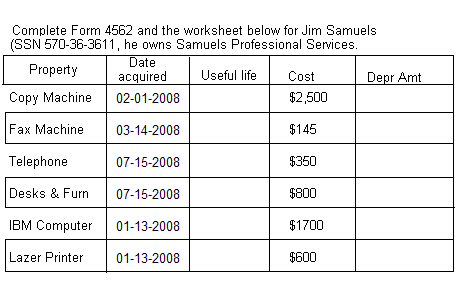|
|
||||||||||||||||||||||||||||||||||||||
|
Tax Lesson 21 - Tax Deduction for Depreciation
|
||||||||||||||||||||||||||||||||||||||
|
This topic covers how to depreciate property. Taking
depreciation is recovering the cost through deductions as when taking special
depreciation allowances and deductions under MACRS. You will also learn how to
opt to take a section 179 deduction, instead of depreciation deductions for
certain property. In addition, you will learn the additional rules that must be
followed for listed property.
Tax School Homepage Student Instructions: Print this page, work on the questions and then submit test by mailing the answer sheet or by completing quiz online. Instructions to submit quiz online successfully: Step-by-Step check list Answer Sheet Quiz Online
Most forms are in Adobe Acrobat PDF format.
Please use IRS Publication 946 to complete this topic. Prepare Form 4562 for Jim Samuels using the following information. Jim will use MCRS to figure his depreciation and he treats his office furniture and equipment as placed in service in the middle of the year (uses the half year convention). Also prepare Form 1040, Schedule C , and Schedule SE. He owns Samuels Professional Services. He started this business in 2008 and dedicates most of his time to its functions. The types of tasks they specialize in include but are not limited to the following:
Complete a return for Jim Samuels.
Income Statement Year Ended December 31, 2008
Expenses:
Estimated payments paid
|
||||||||||||||||||||||||||||||||||||||
| Back to Tax School Homepage |




